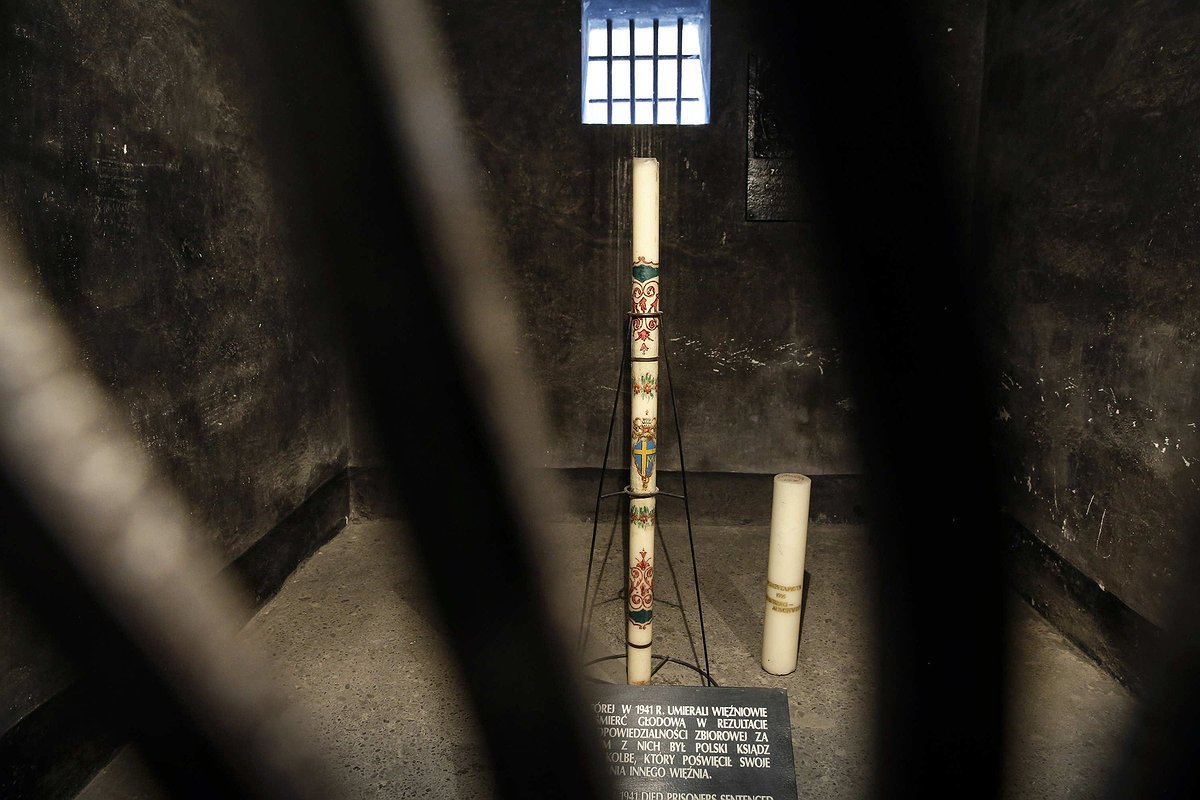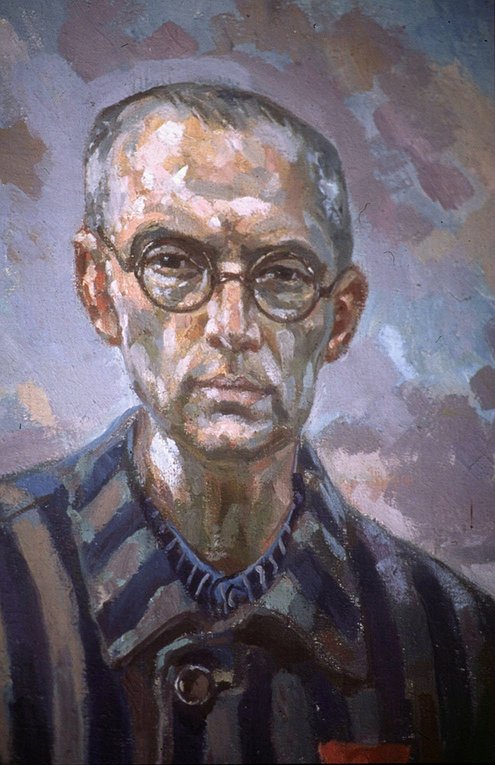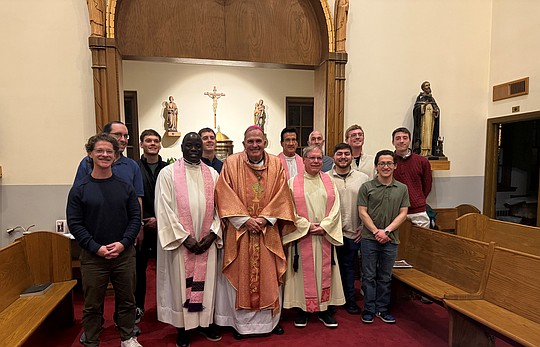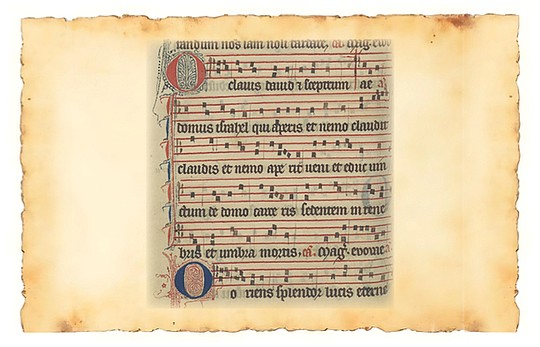St. Maximilian Kolbe: 'Patron of our difficult century'
August 14, 2024 at 1:05 p.m.

OSV News – During his 2016 apostolic visit to Poland for World Youth Day, Pope Francis visited the site of the Auschwitz-Birkenau Nazi death camp in Oswiecim.
Today, the infamous concentration camp area is blanketed by green fields and empty barracks lined by barbed wire fences, a chilling reminder of a horror that remains embedded in history.
The death camp was the Nazis' largest and consisted of three parts: Auschwitz I, where many were imprisoned and murdered; the Birkenau extermination camp – also known as Auschwitz II – and Auschwitz III (Auschwitz-Monowitz), an area of auxiliary camps that included several factories.
 The starvation cell, where St. Maximilian Kolbe and others spent the last days of their lives, is in the basement of block 11 in Auschwitz I at the Auschwitz-Birkenau Memorial and State Museum in Oswiecim, Poland. The cellblock, known as the death block, was used by the SS to inflict torture. (OSV News photo/Nancy Wiechec)
The starvation cell, where St. Maximilian Kolbe and others spent the last days of their lives, is in the basement of block 11 in Auschwitz I at the Auschwitz-Birkenau Memorial and State Museum in Oswiecim, Poland. The cellblock, known as the death block, was used by the SS to inflict torture. (OSV News photo/Nancy Wiechec)Nancy Wiechec
In 1942, Auschwitz became the site of the mass extermination of over 1 million Jews, 23,000 Roma, 15,000 Soviet prisoners of war and thousands of Polish citizens of different nationalities.
Entering through the eerie gates inscribed with the motto, "Arbeit macht frei" ("Work sets you free"), the Pope quietly sat on a small bench with his head bowed, occasionally glancing somberly around before closing his eyes in silent prayer.
After briefly meeting with about a dozen Holocaust survivors, he passed what was known as the "death wall," an area where thousands were lined up and shot in the back of the head before their bodies were sent to the camp's crematoriums.
From there, he made his way toward a darkened cell in the barracks of Block 11, dubbed the "death block" where Nazis mercilessly tortured the innocent. The Pope sat quietly with his head bowed in the tiny cell, illuminated by the faint light of a candle that revealed countless words and even a cross etched on the walls by those who spent their final moments in the starvation cell.
This, however, was no random cell: it was the cell where St. Maximilian Kolbe, a Polish Conventual Franciscan friar, spent his final hours, starved and dehydrated before being administered a lethal injection of carbolic acid.
Canonized by St. John Paul II in 1982, the Catholic Church commemorates his martyrdom Aug. 14. His story, however, is not just one of countless stories of heroic virtue that mark the lives of saints. It also serves as a cautionary tale for humanity's future: a story of selflessness in an era of brazen selfishness as well as a warning of the slippery slope of ideology toward destruction and doom.
Outside St. Maximilian Kolbe's cell, Pope Francis sat down to write a simple message in the visitors' book, a chilling prayer that remains relevant today.
"Lord, have mercy on your people. Lord, forgive so much cruelty."
–'No greater love'–
In his homily during St. Maximilian Kolbe's canonization Mass Oct. 10, 1982, St. John Paul II said the Polish Franciscan was granted the grace of carrying out "in an absolutely literal manner" the words of Christ: "Greater love has no man than this, that a man lay down his life for his friends."
When World War II broke out, St. Maximilian Kolbe chose to stay at the Franciscan Conventual monastery in Niepokalanów, where he ran a radio station and a temporary hospital. After the invasion of Poland, the monastery housed Polish refugees, many of whom were Jewish and published anti-Nazi material.
After his arrest in February 1941, he was transferred to Auschwitz in May of that same year, where he was subject to constant beatings. Despite the conditions, the priest was known by his fellow inmates, including the man whose life he saved, as a saintly person who would share his meager ration of food with others.
In July, as a deterrent after one prisoner escaped, the Nazis selected 10 prisoners to die of starvation in Block 11, including Franciszek Gajowniczek, a Polish soldier who, upon being called, lamented not seeing his wife and children again.
St. Kolbe stepped up and offered to take Gajowniczek's place, which the Nazi commander accepted.
Taken to the "death block," St. Kolbe was among the few remaining prisoners who were still alive after being deprived of food and water for two weeks, where he died on Aug. 14, 1941. His body was cremated at Auschwitz on Aug. 15, the feast of the Assumption.
For Franciscan Father Piotr Bielenin, director of the Institute of Franciscan Studies in Krakow and author of the book, "Wszystko z milosci. Chrystologia sw. Maksymiliana Marii Kolbego" ("Everything from Love: The Christology of St. Maximilian Maria Kolbe"), the Polish priest's sacrifice was not just for Gajowniczek.
"We must not overlook the fact that he went into the starvation bunker also for the other nine prisoners, to accompany them in their last days," Father Bielenin told OSV News Aug. 14 in an email. "Indeed, despite his illnesses, he was the last to die. He died saving, at the same time, the faith in humanity in the other prisoners of the camp."
For Father Bielenin, St. Maximilian was "a man of faith and a true Franciscan" which were two key perspectives that explain his decision to give his life for others. As a priest who commemorated Jesus' sacrifice at Mass, the saint's selfless "act at Auschwitz was not a singular choice but a consequence of his entire life."
"At that decisive moment, he said to the Lagerführer (head SS officer), 'I am a Catholic priest,' meaning, 'I want to offer my life for another, just as Christ did for us,'" Father Bielenin explained.
The example of St. Maximilian Kolbe's life and martyrdom, the Franciscan priest continued, is much needed in today's world, where "human life is often undervalued, starting with unborn children, the victims of wars and injustices, and ending with the elderly."
"It is no coincidence that St. John Paul II called him 'patron of our difficult century,'" Father Bielenin told OSV News.
"St. Maximilian's act gives hope because it shows that even in the most extreme circumstances of life, a person can save their dignity," he said. "One always remains free in their choices. All the darkness of evil is not capable of extinguishing even the smallest flame of love."
However, as the world continues to tread along the path of war and division, particularly along ideological lines, Father Bielenin said that for Christians, the risk "is in adapting the Gospel to the fashion of the world, rather than shaping our lifestyle according to the Gospel."
Another danger, he told OSV News, is "closing ourselves behind the walls of the churches and defending our positions."
"We must throw open the doors of the churches and go out to preach the Gospel in every lawful way, as St. Maximilian did, first of all with his own testimony, aware that for many, the only Gospel they can read is the life of Christians," Father Bielenin said.
Junno Arocho Esteves writes for OSV News from Malmö, Sweden.
The Church needs quality Catholic journalism now more than ever. Please consider supporting this work by signing up for a SUBSCRIPTION (click HERE) or making a DONATION to The Monitor (click HERE). Thank you for your support.
Related Stories
Sunday, December 14, 2025
E-Editions
Events
OSV News – During his 2016 apostolic visit to Poland for World Youth Day, Pope Francis visited the site of the Auschwitz-Birkenau Nazi death camp in Oswiecim.
Today, the infamous concentration camp area is blanketed by green fields and empty barracks lined by barbed wire fences, a chilling reminder of a horror that remains embedded in history.
The death camp was the Nazis' largest and consisted of three parts: Auschwitz I, where many were imprisoned and murdered; the Birkenau extermination camp – also known as Auschwitz II – and Auschwitz III (Auschwitz-Monowitz), an area of auxiliary camps that included several factories.
 The starvation cell, where St. Maximilian Kolbe and others spent the last days of their lives, is in the basement of block 11 in Auschwitz I at the Auschwitz-Birkenau Memorial and State Museum in Oswiecim, Poland. The cellblock, known as the death block, was used by the SS to inflict torture. (OSV News photo/Nancy Wiechec)
The starvation cell, where St. Maximilian Kolbe and others spent the last days of their lives, is in the basement of block 11 in Auschwitz I at the Auschwitz-Birkenau Memorial and State Museum in Oswiecim, Poland. The cellblock, known as the death block, was used by the SS to inflict torture. (OSV News photo/Nancy Wiechec)Nancy Wiechec
In 1942, Auschwitz became the site of the mass extermination of over 1 million Jews, 23,000 Roma, 15,000 Soviet prisoners of war and thousands of Polish citizens of different nationalities.
Entering through the eerie gates inscribed with the motto, "Arbeit macht frei" ("Work sets you free"), the Pope quietly sat on a small bench with his head bowed, occasionally glancing somberly around before closing his eyes in silent prayer.
After briefly meeting with about a dozen Holocaust survivors, he passed what was known as the "death wall," an area where thousands were lined up and shot in the back of the head before their bodies were sent to the camp's crematoriums.
From there, he made his way toward a darkened cell in the barracks of Block 11, dubbed the "death block" where Nazis mercilessly tortured the innocent. The Pope sat quietly with his head bowed in the tiny cell, illuminated by the faint light of a candle that revealed countless words and even a cross etched on the walls by those who spent their final moments in the starvation cell.
This, however, was no random cell: it was the cell where St. Maximilian Kolbe, a Polish Conventual Franciscan friar, spent his final hours, starved and dehydrated before being administered a lethal injection of carbolic acid.
Canonized by St. John Paul II in 1982, the Catholic Church commemorates his martyrdom Aug. 14. His story, however, is not just one of countless stories of heroic virtue that mark the lives of saints. It also serves as a cautionary tale for humanity's future: a story of selflessness in an era of brazen selfishness as well as a warning of the slippery slope of ideology toward destruction and doom.
Outside St. Maximilian Kolbe's cell, Pope Francis sat down to write a simple message in the visitors' book, a chilling prayer that remains relevant today.
"Lord, have mercy on your people. Lord, forgive so much cruelty."
–'No greater love'–
In his homily during St. Maximilian Kolbe's canonization Mass Oct. 10, 1982, St. John Paul II said the Polish Franciscan was granted the grace of carrying out "in an absolutely literal manner" the words of Christ: "Greater love has no man than this, that a man lay down his life for his friends."
When World War II broke out, St. Maximilian Kolbe chose to stay at the Franciscan Conventual monastery in Niepokalanów, where he ran a radio station and a temporary hospital. After the invasion of Poland, the monastery housed Polish refugees, many of whom were Jewish and published anti-Nazi material.
After his arrest in February 1941, he was transferred to Auschwitz in May of that same year, where he was subject to constant beatings. Despite the conditions, the priest was known by his fellow inmates, including the man whose life he saved, as a saintly person who would share his meager ration of food with others.
In July, as a deterrent after one prisoner escaped, the Nazis selected 10 prisoners to die of starvation in Block 11, including Franciszek Gajowniczek, a Polish soldier who, upon being called, lamented not seeing his wife and children again.
St. Kolbe stepped up and offered to take Gajowniczek's place, which the Nazi commander accepted.
Taken to the "death block," St. Kolbe was among the few remaining prisoners who were still alive after being deprived of food and water for two weeks, where he died on Aug. 14, 1941. His body was cremated at Auschwitz on Aug. 15, the feast of the Assumption.
For Franciscan Father Piotr Bielenin, director of the Institute of Franciscan Studies in Krakow and author of the book, "Wszystko z milosci. Chrystologia sw. Maksymiliana Marii Kolbego" ("Everything from Love: The Christology of St. Maximilian Maria Kolbe"), the Polish priest's sacrifice was not just for Gajowniczek.
"We must not overlook the fact that he went into the starvation bunker also for the other nine prisoners, to accompany them in their last days," Father Bielenin told OSV News Aug. 14 in an email. "Indeed, despite his illnesses, he was the last to die. He died saving, at the same time, the faith in humanity in the other prisoners of the camp."
For Father Bielenin, St. Maximilian was "a man of faith and a true Franciscan" which were two key perspectives that explain his decision to give his life for others. As a priest who commemorated Jesus' sacrifice at Mass, the saint's selfless "act at Auschwitz was not a singular choice but a consequence of his entire life."
"At that decisive moment, he said to the Lagerführer (head SS officer), 'I am a Catholic priest,' meaning, 'I want to offer my life for another, just as Christ did for us,'" Father Bielenin explained.
The example of St. Maximilian Kolbe's life and martyrdom, the Franciscan priest continued, is much needed in today's world, where "human life is often undervalued, starting with unborn children, the victims of wars and injustices, and ending with the elderly."
"It is no coincidence that St. John Paul II called him 'patron of our difficult century,'" Father Bielenin told OSV News.
"St. Maximilian's act gives hope because it shows that even in the most extreme circumstances of life, a person can save their dignity," he said. "One always remains free in their choices. All the darkness of evil is not capable of extinguishing even the smallest flame of love."
However, as the world continues to tread along the path of war and division, particularly along ideological lines, Father Bielenin said that for Christians, the risk "is in adapting the Gospel to the fashion of the world, rather than shaping our lifestyle according to the Gospel."
Another danger, he told OSV News, is "closing ourselves behind the walls of the churches and defending our positions."
"We must throw open the doors of the churches and go out to preach the Gospel in every lawful way, as St. Maximilian did, first of all with his own testimony, aware that for many, the only Gospel they can read is the life of Christians," Father Bielenin said.
Junno Arocho Esteves writes for OSV News from Malmö, Sweden.
The Church needs quality Catholic journalism now more than ever. Please consider supporting this work by signing up for a SUBSCRIPTION (click HERE) or making a DONATION to The Monitor (click HERE). Thank you for your support.











